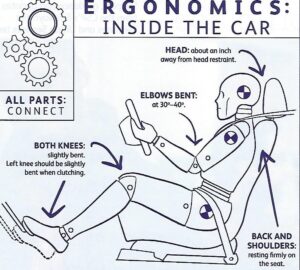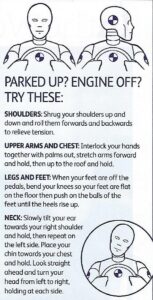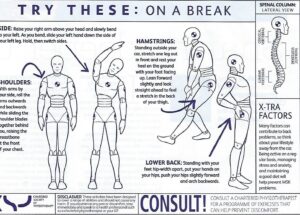My husband and I recently bought a new car. He was driving it one day, for around 2 hours, and found himself becoming increasingly uncomfortable. As in most vehicles, the drivers’ seat is multi-adjustable. The angle and height of the seat, it can be moved forward and backwards, and the angle of the back rest is adjustable. The problem was that he just could not get it right.
Humans evolved to be upright on two feet. The human body was not designed to remain in one position for prolonged periods or to sit for lengths of time. However, modern life often dictates that this is the way we do spend a lot of our time. We work at our desks, we commute long distances, we relax on the sofa.
No matter how ‘good’ the position is, the individual can experience discomfort if it is held for too long.
Car designers are aware of this. They know that many of us spend a lot of time in our cars. As such they have been redesigning the interior of cars for many years to create a more accessible and user-friendly experience for the driver. These days car seats are very adjustable but getting them right for us as an individual can be difficult.
Most people do not know how to set up their drivers’ seat properly and low back, leg or neck pain is not uncommon. The Chartered Society of Physiotherapy (CSP) published an article on this recently. (illustrations used here are taken from Frontline, a publication of the CSP from April 2020 by Lee Sullivan)
The CSP recommends adopting a variety of safe driving positions and has created a step-by-step guide especially for professional drivers. (link https://www.csp.org.uk/publications/drive-clear-pain)
Those of us who commute daily or are planning a long-distance journey may also find the guidelines to be beneficial.
In summary, there are three main areas to consider when driving. In this blog, we are focussing on the driver, but comfort and safety are also relevant for any passengers in the vehicle:
Posture
CSP has suggested a ‘good’ driving posture (see picture above). The back of the individual is well supported on the seat and the knees are slightly bent when depressing the pedals. The elbows are bent to around 30 – 40 degrees, the back is fully supported on the backrest of the seat and the head is around an inch away from the headrest.
Exercises
Whilst stationary with the engine off,
take a moment to carry out some seated exercises. Suggested exercises include shoulder shrugs and rolls, stretching your arms, tilting your head and feet flat on the floor ‘pedalling’ your feet; alternate toe then heel raising.
Breaks
It is recommended that when driving for long periods you stop regularly and perform stretches and movements to counteract the driving position. These include shoulder shrugging and rolling the shoulders backwards whilst straightening the chest. Also suggested are upper back stretches, side bends with one hand above the head, hamstring stretches and lower back stretches. See illustration for more details.
REMEMBER: none of these exercises or stretches should cause pain or discomfort – if they do STOP immediately. For further advice, consult a Chartered Physiotherapist or your GP
For more information or an assessment contact Positive Positioning






